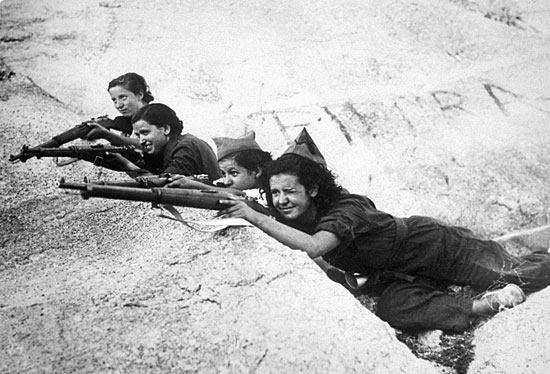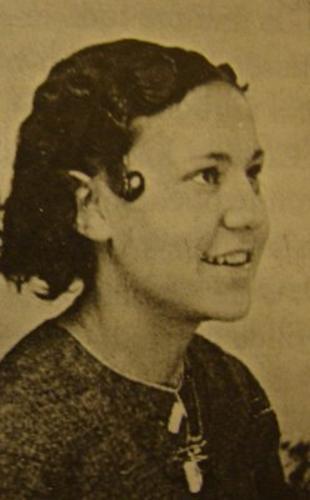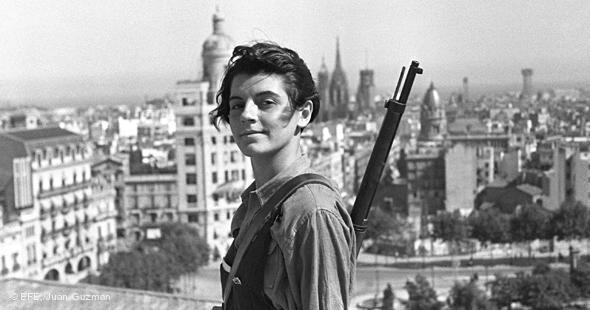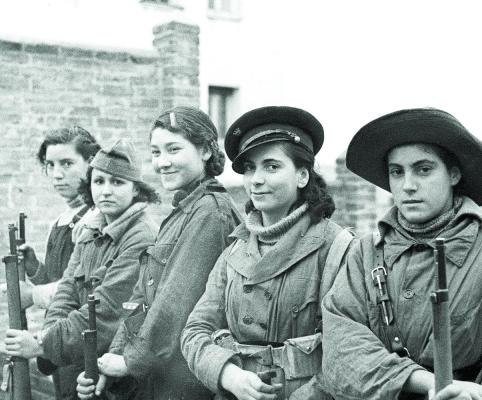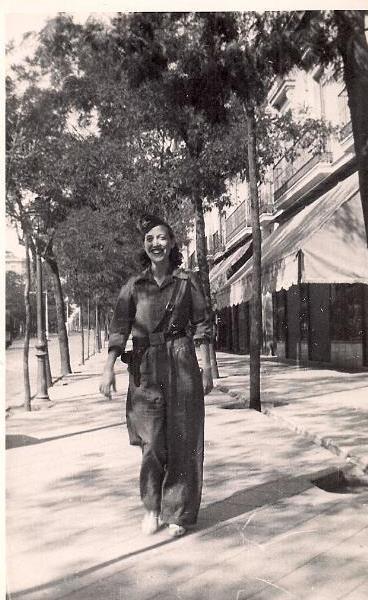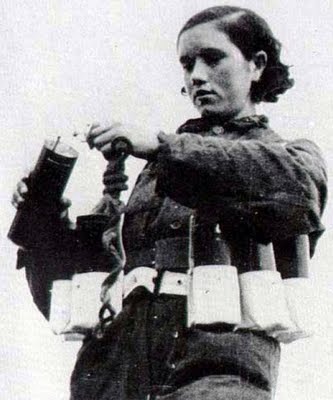Mere anarchy is loosed upon the world,
The blood-dimmed tide is loosed, and everywhere
The ceremony of innocence is drowned;
The best lack all conviction, while the worst
Are full of passionate intensity.
WB Yeats, Easter 1916
On the morning of August 5th 1939 thirteen young women were put against the walls of Madrid’s La Almudena Cemetery and shot…
They were: Carmen Barrero Aguado (age 24), Martina Barroso García (age 22), Blanca Brissac Vázquez (age 29), Pilar Bueno Ibáñez (age 27), Julia Conesa Conesa (age 19), Adelina García Casillas (age 19), Elena Gil Olaya (age 20), Virtudes González García (age 18), Ana López Gallego (age 21), Joaquina López Laffite (age 23), Dionisia Manzanero Salas (age 20), Victoria Muñoz García (age 19), and Luisa Rodríguez de la Fuente (age 18).
They sang the “Youthful Guardsmen,” the anthem of the JSU, as they were taken from the prison they shared with other members of the organization to the cemetery.
Eighty years ago this month, the Spanish cities of Madrid and Valencia fell to the nationalist forces of Francisco Franco. Victory was proclaimed as Franco placed his sword to rest upon the altar of a church declaring that he wouldn’t raise the blade again until Spain was in peril. The Spanish Civil War that had claimed hundreds of thousands of lives (upwards of half a million, possibly up to two) was at an end; the long march of the generalissimo was over and the reign of the Caudillo had begun. It endured until his death in 1975.
The Spanish Civil War was long, brutal and bloody, and medieval in its savagery. It was a war of armies and of militias, of men and women, of skirmishes and set-piece battles, of massacres and reprisals, and of wars within wars. It saw cities besieged and starved into surrender and towns destroyed by bombers and heavy artillery. It cut a swathe across the country leaving scars that endure to this day.
It became a proxy war for three dictators – Hitler, Mussolini and Stalin – who dispatched men and machines to fight under false flags in what would appear in retrospect to be a rehearsal for wars to come. It was a magnet for idealists and activists of disparate political creeds and from many lands who were to fight and die on both sides, including the celebrated International Brigades. It lured writers and poets who were to chronicle its confusion and carnage, including Ernest Hemingway, George Orwell, WH Auden, André Malraux and Arthur Koastler. Many perished, the most famous being the Spanish poet Federico García Lorca, murdered by Nationalist militia and buried in an unmarked grave, one of many unquiet graves scattered throughout the land.
Since Franco’s death, successive Spanish governments have endeavoured to heal the wounds of the war and the dictatorship by condoning what could be described as historical amnesia. And yet, such official forgetfulness, well-intentioned as it might be, is often suborned by our species’ instinctive need to remember and to memorialize our dearly departed.
Valle de los Caidos, the Valley of the Fallen, in the Sierra de Guadarrama mountains near Madrid, is one such monument. This grandiose necropolis hosts a mass grave of some 34,000 war dead of all sides, as well as the tombs of an embalmed Franco and of José Antonio Primo de Rivera, the founder of the fascist Falange Española. It is a shrine and a place of pilgrimage for nationalists and Falangists old and young, and a bitter reminder for the families and friends of the vanquished.
The current socialist government has shattered the deafening silence. it is determined to move Franco’s remains out the basilica and to make the Valley of the Fallen a more neutral place to honour the victims of the war and its vengeful aftermath.
The mass graves of Spain’s civil war victims is a live issue as the nation comes to terms with its history. Even the weather compels the soil to give up its dead, revealing the scale and the savagery of the slaughter that followed the victory of Franco’s Nationalists. Recent storms have swept away soil in an area of Madrid’s La Almudena public cemetery, exposing the bones of three thousand people executed on the orders of Francoist military courts in the five years after Spain’s civil war ended in 1939. They include, it is believed, the remains of Las Treces Rosas, the Thirteen Roses.
Outside the history books and the stories, songs and folk memories of ageing socialists and anarchists, there is but limited interest, knowledge and understanding of the causes, chronology and consequences of the civil war – and I am not about to rectify that in this post. Click here to and here to read reasonable synopses.
Rather, I will take the opportunity to publish a story about the war – one tragedy among so many – that illustrates its systematic ruthlessness. Here is the story of those thirteen young victims.
Thirteen roses ..and forty three carnations
On the morning of August 5th 1939 thirteen women were shot dead against the walls of Madrid’s La Almudena Cemetery.
Nine were minors, because at that time the age of majority was not reached until twenty-one. Ranging in age from 18 to 29, all had been brought from the Sales women’s prison, a prison that was designed for 450 people and in 1939 contained 4,000. Apart from Brisac Blanca Vazquez, all belonged to the Unified Socialist Youth (JSU) or PCE (Communist Party of Spain). Although they had not participated in the attack that killed Isaac Gabaldon, commander of the Civil Guard, they were charged with being involved and conspiring against the “social and legal order of the new Spain”.
The trial was held on August 3rd and 56 death sentences were issued, including the perpetrators of the attack. The Thirteen Roses went to their execution hoping to be reunited with their JSU comrades. In some cases it would have meant a boyfriend or husband but their hopes crumbled upon learning that the men had been shot already.
The brick wall clearly showed the bullet holes and the earth had been turned dark by blood. Some days, the death toll exceeded two hundred and machine guns were used to facilitate the work. Between 1939 and 1945, four thousand people were shot in the Eastern Cemetery, including Julián Zugazagoitia, Minister of the Interior with Juan Negrín and remarkable writer and socialist politician.
According to Maria Teresa Igual, prison officer and eyewitness, the Thirteen Roses died with fortitude. There were no screams or pleas. In an eerie half-silence, only the steps of the firing squad were heard, the sound of the guns striking the straps and the voice of the commanding officer. Lined up shoulder to shoulder, after the shooting all received the coup de grace, which was clearly heard in the Sales women’s prison. Apparently, one of the condemned (whether Anita or Blanca is not known), did not die immediately and had shouted, “Am I not to be killed?”
Antonia Torre Yela was spared execution by a typing error. In transcribing her name, the letters danced and became Antonio Torres Yera. The error only postponed death for Antonia, a member of the JSU and only 18. She was shot on February 19th, 1940, becoming the 14th Rose. In her farewell letter, Julia Conesa, nineteen and member of the JSU, wrote: “Let my name not be erased from history.” Her name and that of her comrades has not been forgotten, unlike those of their tormentors, who enjoyed impunity for 38 years of dictatorship and a shameful amnesty which only helped to deepen the hurt suffered by all victims of Francoism.
The PSOE (main social-democratic party — DB) tried to appropriate the Thirteen Roses, concealing that at the time of the executions the PSOE had split from the JSU to found the Socialist Youth of Spain (JSE), with the purpose of clearly distancing themselves from the Communist Party of Spain (PCE). In fact, the Law of Historical Memory of Zapatero’s government (the first PSOE government after Franco — DB) did not even consider overturning the dictatorship’s judicial verdicts. It should be remembered that nearly fifty men were also shot dead that sad August 5th, the “43 Carnations”. Franco showed the same ruthlessness to men and women.
A hell
Sales jail was a hell, with children, elderly and mothers with children huddled in hallways, stairs, patios and bathrooms. Manuela and Teresa Basanta Guerra were the first women executed against the walls of the Eastern Cemetery. They shot them on June 29th 1939 along with a hundred men. Some historians claim that other women preceded them but their names were not recorded in the cemetery’s files. Like others on death row, the Thirteen Roses could only write to their families after receiving confession. If they did not take confession, they gave up the opportunity to say goodbye to their loved ones.
Brisac Blanca was the eldest of the thirteen and active in no political organization. Catholic and one who voted for the Right, she nevertheless fell in love with a musician who belonged to the PCE, Enrique Garcia Mazas. They married and had a son. Both were arrested and sentenced to death in the same trial. In fact, Enrique was in Porlier prison and would be shot a few hours before her. Blanca wrote a letter to her son Enrique, asking him not to harbour ill-will towards those responsible for her death and to become a good and hardworking man.
In postwar Madrid there was vicious persecution and resentment of any citizen suspected of “joining the rebellion”, the technicality that was used to reverse the law, accusing supporters of the Second Republic of violating the law in force. Only the military, the clergy, the Falange and the Carlists could breathe easily. No one dared to walk around in workers’ overalls or wearing the traditional local bandanna (worn by men around the neck and by women as a kerchief around the head, it is still worn today at festival in Madrid — DB).
The city was a huge prison where “hunt the red” was taking place. The earlier militia-women aroused particular animosity. The Arriba newspaper edition of May 16th 1939, featured an article by José Vicente Puente in which his contempt does not mince words: “One of the greatest tortures of the hot and drunk Madrid were the militia-women parading openly in overalls, lank-haired, with sour voice and rifle ready to shoot down and end lives upon a whim to satiate her sadism. With their shameless gestures, the primitive and wild, dirty and dishevelled militiawomen had something of atavism, mental and educational. … …. They were ugly, low, knock-kneed, lacking the great treasure of an inner life, without the shelter of religion, within them femininity was all at once extinguished.”
In this climate of hatred and revenge, denunciations proliferated — they were the best means of demonstrating loyalty to the fascist Movement.
The interrogations …. copied Gestapo tortures
The interrogations in police stations copied Gestapo tortures: electric shock on the eyes and genitals, the “bathtub”, removing fingernails with pliers, mock executions. Women suffered especially because the torture was compounded by sexual abuse, castor oil and hair cut down to the scalp. In some cases they even shaved eyebrows to further depersonalize. Rapes were commonplace. The testimony of Antonia Garcia, sixteen, “Antoñita” is particularly chilling: “They wanted to put electric currents on my nipples but since I had no chest they just put them in my ears and burst my eardrums. I knew no more. When I came to I was in jail. I spent a month in madness”.
Among those responsible for the interrogations was General Gutierrez Mellado, hero of the Transition and Captain in the Information Service of the Military Police (CPIS ) during the toughest years following the war. He regularly attended executions, seeking last-minute confessions. On August 6th 1939 he pulled Cavada Sinesio Guisado, nicknamed “Pioneer”, military chief of the JSU after the war, out of the execution line. “Pioneer” had been lined up against the Eastern Cemetery wall and was awaiting the discharge of lead along with the rest of his comrades. Gutiérrez Mellado stepped forward and ordered his release. He forced him to witness the executions and asked for more information about PCE clandestine activity. Although he was cooperative and diligent, he was shot in the end on September 15th. Some claim that Gutierrez Mellado witnessed the execution of the Thirteen Roses but I was not able to verify the data.
The women’s prison in Sales was run by Carmen Castro. Her inflexibility and lack of humanity found expression in the conditions of life of the children in prison with their mothers. No soap or hygienic facilities — almost all had ringworm, lice and scabies. Many died and were placed in a room where the rats were trying to devour the remains. Adelaida Abarca, JSU activist, said the bodies were only skin and bones, almost skeletons, for hunger had consumed them slowly. Another prisoner said: “The situation of the children was maddening. They were also dying and dying with dreadful suffering. Their glances, their sunken eyes, their continuous moans and stench are branded on my memory.” (Testimony given to Giuliana Di Febo in Resistance and the Women’s Movement in Spain [1936-1976] , Barcelona 1979).
The prisoners lived within the shadow of the “pit”, the death penalty. Since the execution of the Basanta Guerra sisters, they knew that the regime would have no mercy on women. On the morning when the Thirteen Roses were shot, Virtudes Gonzalez ‘s mother was at the jail doorway. When she saw her daughter climbing into the truck that was carrying prisoners to the cemetery walls, she began shouting: “Bastards ! Murderers ! Leave my daughter alone!” She chased the truck and fell. Alerted by the commotion, the Sales jail officers went outside and picked her off the ground, taking her into the prison. She was kept inside as yet another prisoner.
“If I had been sixteen they would have shot me too”
No less dramatic were Enrique’s repeated attempts to find out the whereabouts of his parents, Blanca and Enrique Garcia Brisac Mazas. In an interview with journalist Carlos Fonseca , author of the historical essay Thirteen Red Roses ( Madrid, 2005 ), Enrique gave his bitter account: “I was eleven years old when they shot my parents and my relatives tried to conceal it. They said they had been transferred to another prison and therefore we could not go to see them, until one day I decided to go to Salesas and there a Civil Guard Brigadier told me they had been shot and that if I had been sixteen they would have shot me too, because weeds had to be pulled up by the roots.
My grandmother and my aunts, my mother’s sisters, who had fallen out with my mother, ended up telling me that if Franco had killed my parents it would be because they were criminals. They even concealed my mother’s farewell letter for nearly twenty years.”
I will not end this article by invoking reconciliation, because the Transition was not based on repairing the pain of the victims, but rather on the acquittal of the executioners. In fact, the reform of the criminal dictatorship was designed by those as low as Manuel Fraga, Rodolfo Martín Villa and José María de Areilza. Martín Villa concealed and destroyed documents to bury the crimes of Francoism and the dirty war he organized against anarchist and pro-independence activists of the Basque, Catalan and Canaries areas, from his post as Minister of the Interior between 1976 and 1979. Among his achievements one should list the Scala case (an attack that killed four workers, which was blamed on the CNT), the attempted assassination of Canaries independence leader Antonio Cubillo, the machine-gunning of Juan Jose Etxabe, historic leader of ETA and his wife Rosario Arregui (who died from eleven bullet wounds), also the murder of José Miguel Beñaran Ordeñana, “Argala”.
The impunity of the perpetrators
He is now a successful businessman, who gets excited talking about his role in the Transition. He lives quietly and no one has called for his prosecution. His example is an eloquent one of the impunity of the perpetrators, who continue to write the narrative while demonizing those who dared to stand against the miseries of the dictatorship and false democratic normalization.
No justice has been done. So it is absurd to talk of reconciliation, because nobody has apologized and repaired the damage. Franco committed genocide but today Manuel Gonzalez Capón, Mayor of Baralla (Lugo), of the Partido Popular (the main right-wing party), dares to declare that “those who were sentenced to death by Franco deserved it.” The Biographical Dictionary of the Royal Academy of History, funded with nearly seven billion euros of public funds, says Franco “set up an authoritarian but not totalitarian regime”, although in his speech in Vitoria/ Gastheiz, Franco himself said that “a totalitarian state in Spain harmonises the functioning of all abilities and energies of the country …”. The current scenario is not a reconciliation but instead is a humiliation of the victims and society, obscenely manipulated by a media (ABC, El País , El Mundo, La Razón), playing a similar role to newspapers of the dictatorship (ABC, Arriba, Ya, Pueblo, Informaciones, El Alcázar), covering up and justifying torture cases and applauding antisocial measures that continue reducing working class rights.
Let us not remember the Thirteen Roses as passive and submissive but instead for their courage and determination. With the exception of Blanca, trapped by circumstances, all chose to fight for the socialist revolution and the liberation of women. I think that if they were able to speak out today, they would not talk of indignation and peaceful disobedience, but would ask for a rifle to stand in the vanguard of a new anti-fascist front, able to stop the crimes of neo-liberalism. Let us not betray their example, forgetting their revolutionary status, they who sacrificed their lives for another world, one less unjust and unequal.
Postscript
Just as the Civil War stirs Spain’s historical memory, so the spectre of the Paris Commune of 1870 haunts still the French soul. One can walk through the centre of modern Paris from the Louvre to the celebrated Père Lachaise cemetary Père Lachaise retracing the steps of defeated communardes as retreated to to last stand among the tombstones. It was there, in front of la Mur des Fédérés that the bloodied and ragged survivors were lined up and shot.
The beautiful church of Sacre Coeur was built as a penance for, and a solemn reminder of the bloodletting of what is aptly called la semaine sanglante – in much the same way as Justinian raised the glorious Hagia Sophia in Constantinople as a form of contrition after the Nika Riots when his soldiers slaughtered tens of thousands of his rebellious citizens and buried their bodies under the Hippodrome.
See also in In That Howling Infinite:
- A House Divided – the nature of civil war
- Rebel Yell
- Pity the Nation
- Sic Semper Tyrannis
- A Brief History of the Rise and Fall of the West
- Land and Freedom (Ken Loach’s movie)
The Spanish Civil War – a brief overview
80 years ago today in 1939, as the world waited with bated breath on Hitler’s next move in Central Europe, in Spain, with the help of allies within the city, Madrid fell to the Nationalist forces of Generalissimo Francisco Franco. The next day, beleaguered Valencia would also fall and a few days after that victory was proclaimed as Franco placed his sword to rest upon the altar of a church declaring not to raise the blade again until Spain was imperiled. The Spanish Civil War that had claimed hundreds of thousands of lives was thus at an end, and the reign of the Caudillo had begun in earnest that was to last until his death in 1975.
Born in 1892 in Galicia, Franco belonged to a devoutly Catholic upper class family with a long tradition of serving in the Spanish navy. Unable to follow in the footsteps of his forefathers, Franco had chosen the army instead at the age of 14 and conducted himself with disciplined excellence from the outset, swiftly gaining a reputation as a highly professional and trusted leader of fighting men at a time when the Royal Spanish army was characterized by a general sloppiness and lack of discipline. A severe and austere man who placed his faith in tradition, Catholicism, and the monarchy, Franco had risen up through the ranks as the youngest officer in the army in Spain’s colonial wars in Morocco as an example to them all. When the Spanish monarchy was abolished in 1931 Franco was disgusted, not least because shortly afterwards the new republic laid him off and placed him on the inactive list. Franco accepted his fate like a soldier and patiently waited until a conservative government came to power and he was called back to service, jumping back into military life with alacrity as Spain’s political system steadily disintegrated. By 1936 however he could stand by no longer and watch his country fall apart, after much hesitation he joined with his fellow officers and rebelled against the Republic, marching an army into Spain from North Africa and starting the long and bloody struggle against the Republicans supported by the USSR and the International Brigades whilst Franco received aid from Fascist Italy and Nazi Germany. With the death of all the other major military leaders by late 1936, Franco was chosen as the man to lead the Nationalists to victory and as the war drew to a close his government was recognised by the British and French governments.
Despite popular depictions of him as a Fascist dictator akin to Hitler and Mussolini, Franco in truth had little time for Fascism. While he certainly presided over a one-party state, unlike in Italy and Germany, the party firstly was not on a par with the state and secondly only a component of it, the Phalange, were Fascists, the rest were Carlist monarchists, traditionalists and conservatives. As a committed Catholic and monarchist, Franco had no time for the esotericism and mysticism of National Socialism and Fascism. While Hitler and Mussolini both had experience of war along with much of their inner circle, they were not of the upper officer echelons as Franco was. He was a military dictator, not a messianic god-like figure of a mass movement. The characterization of his regime as totalitarian is also problematic too since totalitarian would imply that he ruled through terror, annihilating segments of the population beyond those who were openly opposed to his regime. Tens of thousands did indeed perish under his regime with summary executions in the White Terror that followed his Civil War victory coupled with the brutal campaigns against sporadic rebellions and expressions of dissent in subsequent years, however he did not go beyond crushing those he did not need to to stay in power, he did not seek out a helpless ‘objective enemy’ that was to be continuously exterminated as was the case in Nazi Germany and Stalinist Russia. His interest was not a radical reshaping of the world but as might be expected of a man of his background and career, order, stability, and a restoration of traditional norms.
That all being said he was undoubtedly predisposed towards the Axis powers due to his hatred of Communism and no doubt a certain degree of debt he owed to them after their help in the Civil War. Despite his country having gone through three hellish years of war he was more than eager to join the Axis after the Fall of France in 1940. He envisioned the formation of a Latin Bloc to dominate the Mediterranean consisting of Spain, Italy, the Vatican, Vichy France, and Portugal. That year he met Hitler in Hendaye to discuss this possibility. At this meeting between the Caudillo and the Führer, Franco laid down his conditions: he wanted food, fuel and supplies for his country in the event of an Allied naval blockade, in expectation of Britain’s defeat he wanted Gibraltar along with French Morocco, a portion of Algeria and the colony of Cameroon. This proved too high a price to pay, the demand on Cameroon was especially jarring to Hitler since this had been a German colony prior to 1919. Mussolini moreover had his eye on Algeria. In the end the three dictators could not reconcile themselves to one another and Spain remained neutral though volunteers were sent to aid the Axis against the USSR in the form of the Blue Division. Franco likewise refused any prospect of the Wehrmacht being allowed to march through Spain to take Gibraltar themselves, a move which had it been made could have crippled the British position in the Mediterranean and altered the course of the war completely. Spain remained independent, remaining friendly with the Axis but not so much as to be roped into their ungodly self-destruction. During the war he was credited by having given sanctuary to tens of thousands of Jews fleeing the Nazi Empire.
Spain found itself isolated in the immediate aftermath of the war and was excluded from the Marshall Plan. With the mounting tensions of the Cold War however the Western powers slowly started to align themselves with the conservative anti-communist military dictator. In 1953 President Eisenhower visited the country and concluded the Pact of Madrid which brought Spain out of isolation and eventually led to the country joining NATO. Many of the old guard in charge of the economy were replaced by technocrats who brought in a free market economy. By the 1960s economic growth rocketed upwards, resulting in the Spanish Miracle, giving rise to a new middle class. The colonial empire moreover which Franco had so passionately fought for in the past was steadily let go of with both Morocco and Equatorial Guinea let go of by the end of the 1960s. Behind this economic prosperity however the regime remained as traditional as ever, with strict Catholic morality on abortion, divorce, homosexuality and prostitution holding sway in both law and society. Women were confined to the home and had practically no rights, their financial affairs managed by their fathers and husbands. Any languages or traditions not considered Spanish enough were systemically suppressed. When university students protested in the 1960s and the 1970s against the regime, Franco resorted to his old ways and crushed them.
The Caudillo was an old man now though and by the early 1970s he recognised that death was moving upon him. Before death could claim him he decided to restore the monarchy – even though the country had always officially been a monarchy since he had taken power. Though he initially offered the throne to Otto von Habsburg, the last Crown Prince of Austria-Hungary, in a bid to restore Spain to her Habsburg Golden Age and to avoid another Carlist War of succession. In the end however he gave it to the Carlist pretender, Juan Carlos of the House of Bourbon. Franco died in late 1975. His regime was swiftly converted to a democracy with the help of the new king.l




